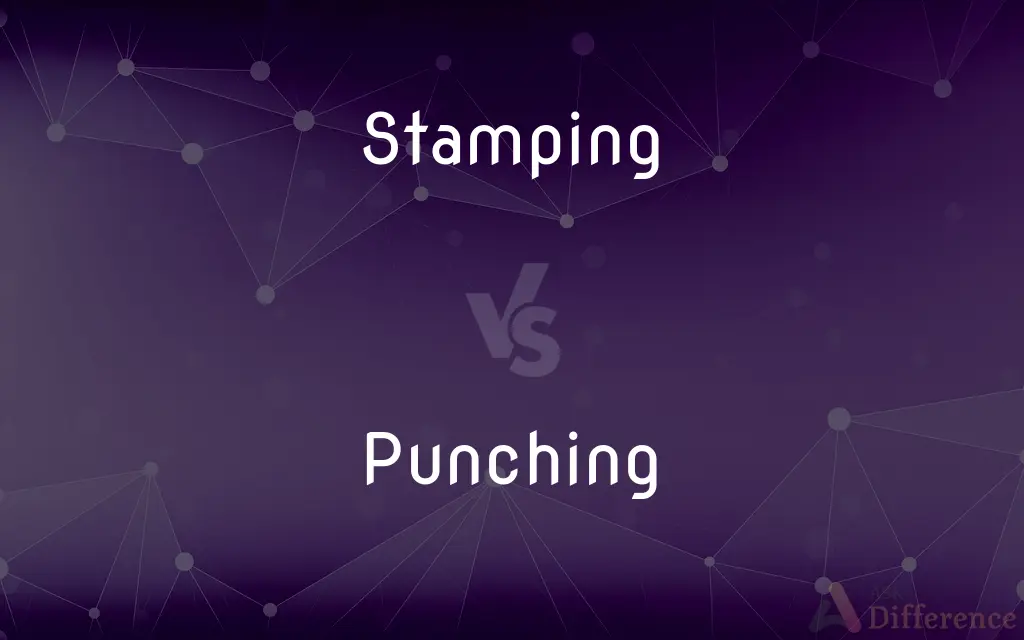Stamping vs. Punching — What's the Difference?
Edited by Tayyaba Rehman — By Maham Liaqat — Updated on March 26, 2024
Stamping shapes materials with a die, creating intricate designs, whereas punching creates holes in materials, focusing on removing pieces.

Difference Between Stamping and Punching
Table of Contents
ADVERTISEMENT
Key Differences
Stamping is a manufacturing process that uses a stamp or die to shape or cut materials, often metal, into desired forms or patterns. It's used for creating detailed components, embossing, and decorative work, emphasizing the formation of specific shapes or designs. Punching, on the other hand, is a process specifically aimed at creating holes in a material by driving a punch through it and into a die below. It focuses on the removal of material to create openings rather than shaping the material itself.
While stamping can involve a variety of operations including bending, embossing, and coining, all of which alter the surface or shape of the material without necessarily removing material, punching is distinctly about the removal of material to create holes or cutouts. Stamping operations can be complex, requiring multiple stages and dies to achieve the final product, whereas punching is generally a more straightforward operation, often performed as part of the larger manufacturing process.
In terms of applications, stamping is widely used in automotive, electronics, and appliance manufacturing, where components with complex shapes and designs are required. Punching finds its utility in creating perforated sheets, chassis for electronic components, and any part that requires precise holes or cutouts.
Understanding the distinction between stamping and punching is crucial for selecting the appropriate manufacturing process based on the desired outcome. While both processes are fundamental in metalworking and manufacturing, their specific applications and capabilities cater to different needs in the production of parts and components.
Comparison Chart
Process
Uses a die to shape or cut materials
Creates holes by driving a punch through the material
ADVERTISEMENT
Focus
Shaping materials into detailed designs
Removing pieces of material to create holes
Operations
Bending, embossing, coining, and more
Primarily focused on hole creation
Material Removal
Not primarily focused on removal, more on deformation
Focuses on the explicit removal of material
Applications
Automotive, electronics, appliances for complex shapes
Perforated sheets, electronic chassis, parts requiring holes
Compare with Definitions
Stamping
Creates detailed components and designs.
Appliance manufacturers use stamping to produce durable and aesthetically pleasing parts.
Punching
Removes pieces of material to create openings.
Perforated panels are typically made using punching techniques.
Stamping
A process that shapes materials using dies.
Automotive panels are often made using stamping processes for their complex shapes.
Punching
Utilized for parts requiring precise holes or cutouts.
Computer chassis often have punched holes for ventilation and cable management.
Stamping
Can include operations like embossing or coining.
Jewelry pieces are frequently created through stamping to achieve intricate designs.
Punching
A process to create holes in materials.
Punching machines are used to create precise holes in metal sheets for construction.
Stamping
Focused on forming rather than removing material.
Stamping is used in the electronics industry to create detailed metal components.
Punching
Straightforward operation within manufacturing.
Punching is a standard step in the production of electronic component chassis.
Stamping
Involves multiple stages and dies for final product.
The creation of a stamped metal part might require several dies to complete the design.
Punching
Focuses on the explicit removal of material.
Punching processes are essential for creating components with necessary functional openings.
Stamping
To bring down (the foot) forcibly.
Punching
Punching is a forming process that uses a punch press to force a tool, called a punch, through the workpiece to create a hole via shearing. Punching is applicable to a wide variety of materials that come in sheet form, including sheet metal, paper, vulcanized fibre and some forms of plastic sheet.
Stamping
To bring the foot down onto (an object or surface) forcibly.
Punching
A tool for circular or other piercing
A leather punch.
Stamping
To cause to be dislodged by stomping the feet
He stamped the snow from his boots.
Punching
A tool for forcing a pin, bolt, or rivet in or out of a hole.
Stamping
To subdue, destroy, or eliminate
Stamped the rebellion.
Stamp out a fire.
Punching
A tool for stamping a design on a surface.
Stamping
To crush or grind with a heavy instrument
Stamp ore.
Punching
A tool for making a countersink.
Stamping
To form or cut out by application of a mold, form, or die
Washers that were stamped from a piece of sheet metal.
Punching
A blow with the fist.
Stamping
To imprint or impress with a mark, design, or seal
Stamp a passport.
Punching
Impressive or effective force; impact.
Stamping
To impress forcibly or permanently
An experience that was stamped on his memory.
Punching
To make (a hole or opening), as by using a punch or similar implement.
Stamping
To affix an adhesive stamp to (an envelope, for example).
Punching
To make a hole in (something), as by using a punch
The conductor punched my train ticket.
Stamping
To identify, characterize, or reveal
Stamped her as a traitor to the cause.
Punching
To pierce something; make a hole or opening
My foot punched through the ice.
Stamping
To thrust the foot forcibly downward
Stamp on the brake pedal.
Punching
To hit with a sharp blow of the fist.
Stamping
To walk with forcible, heavy steps.
Punching
To drive (the fist) into or through something.
Stamping
The act of stamping.
Punching
To drive (a ball, for example) with the fist.
Stamping
An implement or device used to impress, cut out, or shape something to which it is applied.
Punching
To make (a hole) by thrusting the fist.
Stamping
An impression or shape formed by such an implement or device.
Punching
(Archaic) To poke or prod with a stick.
Stamping
An official mark, design, or seal that indicates ownership, approval, completion, or the payment of a tax.
Punching
Western US To herd (cattle).
Stamping
A small piece of gummed paper sold by a government for attachment to an article that is to be mailed; a postage stamp.
Punching
To depress (the accelerator of a car) forcefully.
Stamping
A similar piece of gummed paper issued for a specific purpose
Trading stamps.
Punching
To depress (a key or button, for example) in order to activate a device or perform an operation
Punched the "repeat" key.
Stamping
An identifying or characterizing mark or impression
His work bears the stamp of genius.
Punching
To enter (data) by keying
Punched in the number on the computer.
Stamping
Characteristic nature or quality
A person of her stamp.
Punching
(Baseball) To hit (a ball) with a quick short swing.
Stamping
The sound or action of one who stamps.
Punching
Present participle of punch
Stamping
A method of manufacturing using dies and extreme pressure.
Punching
Gerund of punch
Stamping
A part made by such a method.
Punching
An incident in which someone is punched.
Punching
The process of making holes in something (for example, a leather belt or a rail ticket).
Common Curiosities
What is the main difference between stamping and punching?
The main difference lies in their focus: stamping shapes materials into designs or patterns without necessarily removing material, whereas punching specifically creates holes, removing material in the process.
Is stamping only used for metal?
While metal is the most common material, stamping can also be applied to plastics, paper, and other materials for various applications.
What kind of holes does punching create?
Punching can create holes of various sizes and shapes, depending on the punch and die used, ranging from simple round holes to complex geometric shapes.
Are there limitations to the thickness of materials that can be punched?
Yes, the thickness and type of material can affect the punching process, with thicker or harder materials requiring more force or specialized punches.
What are the typical industries that use stamping?
Industries such as automotive, electronics, appliances, and jewelry frequently use stamping for its versatility in creating complex shapes and designs.
Can stamping and punching be used together?
Yes, in many manufacturing processes, stamping and punching are used together to both shape and create holes in parts as required.
Why choose stamping over other forming processes?
Stamping is chosen for its ability to produce complex shapes with high precision and repeatability, particularly useful in mass production.
Can punching be considered a type of stamping?
In a broad sense, punching can be seen as a specific operation under the wider umbrella of stamping processes, focused exclusively on creating holes.
How does the cost of stamping compare to punching?
Stamping, especially for complex parts, can involve higher initial costs due to the need for multiple dies and setup, whereas punching is generally simpler and less expensive for creating holes.
How does material removal in punching affect the final product?
The removal of material in punching not only creates necessary openings but can also influence the structural integrity and weight of the final product, requiring careful design consideration.
Share Your Discovery

Previous Comparison
Bilingualism vs. Multilingualism
Next Comparison
Overalls vs. BibAuthor Spotlight
Written by
Maham LiaqatEdited by
Tayyaba RehmanTayyaba Rehman is a distinguished writer, currently serving as a primary contributor to askdifference.com. As a researcher in semantics and etymology, Tayyaba's passion for the complexity of languages and their distinctions has found a perfect home on the platform. Tayyaba delves into the intricacies of language, distinguishing between commonly confused words and phrases, thereby providing clarity for readers worldwide.
















































